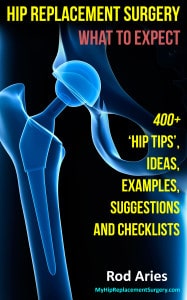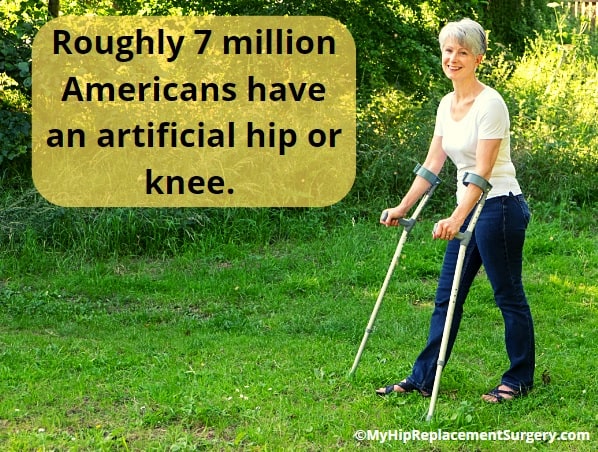Chapter 2 – Is Hip Surgery Really That Quick And Easy? A Brief Summary Of Hip Replacement Surgery
Chapter 2 – Is Hip Surgery Really That Quick And Easy? A Brief Summary Of Hip Replacement Surgery

- Hip Pointers
- First A Speedy Sneak Preview
- Just What Is A Total Hip Replacement?
- How Your Hip Is Just Like Legos
- A (Very) Brief History Of Hip Replacement Surgery
- You Are Not Alone
- How Does Your Chance Of Having A Hip Replacement Compare To Your Chances Of Winning The Lottery?
- Your Experience May Vary
- Close Encounters Of The Hip Kind
- “I See Dead People,” Diagnosis By A Car Salesman
- I Am A Psychic Too
- How A Physician Conducts A Physical Exam To Determine If You Need A Hip Replacement
- More Anesthesia! (Part One)
- Anesthesia Awareness: Just what is anesthesia awareness?
- None Shall Sleep
- Your Hip Pain Is Not Going To Get Better
- Well, It Does Get Better
- It’s Complicated

Hip Replacement Surgery
Hip Pointers – This chapter discusses what a total hip replacement actually is, the chances of you needing a hip replacement (which will be higher than you think), a brief history of the surgery, and how someone I didn’t even know — a total stranger (much like me to you) — diagnosed my need for a hip replacement even before I knew it. And, most importantly, the repeated warning, “Your hip is NOT going to get better.”
First A Speedy Sneak Preview – Total hip replacement surgery generally takes less than two hours and you can typically be walking on your new hip within 24 hours. Wow, wasn’t that quick and easy?
Just What Is A Total Hip Replacement? Total hip replacement (THR) is a procedure whereby an orthopedic surgeon replaces your painful, dysfunctional hip joint with a highly functional, long-lasting artificial joint. It’s almost as easy as replacing a burned out light bulb.

An arthritic hip on the left, after total hip replacement is on the right. That is a metal prosthesis placed into a hole drilled into your femur. The other end is a receiving cup screwed into your hip.
How Your Hip Is Just Like Legos – Your hip is a ball-and-socket joint and ‘snaps’ together. The round head of your thighbone (femur) moves inside this hollow socket (acetabulum) of your pelvis. This anatomical fit is what allows your leg to move easily from your hip.
To replicate this action in a failing hip, a THR implant consists of three parts:
- stem (fits into your femur and provides stability)
- ball (replaces the spherical head of your femur)
- cup (replaces your worn-out hip socket)
Each part comes in various sizes in order to accommodate various body sizes and types. In short, a total hip replacement is just what it says: your doctor replaces the bones in your hip with artificial material.
A (Very) Brief History Of Hip Replacement Surgery – The American Academy of Orthopaedic Surgeons (AAOS) states the following: “First performed in 1960, hip replacement surgery is one of the most important surgical advances of the last century. Since 1960, improvements in joint replacement surgical techniques and technology have greatly increased the effectiveness of total hip replacement.”
“We read to know that we are not alone.”
C.S. Lewis
You Are Not Alone – The CDC reports there are over 330,000 hip replacements per year in the United States. At a recent conference of the AAOS, it was reported that there are 400,000 annual replacements.
“My wife said to me: ‘If you won the lottery, would you still love me?’ I said: ‘Of course I would. I’d miss you, but I’d still love you.’”
Frank Carson
How Does Your Chance Of Having A Hip Replacement Compare To Your Chances Of Winning The Lottery? Well, the short answer is… “You’re a winner!” If you have an artificial joint, like two of every 100 Americans (7 million people), you are part of a special group of those with surgically repaired knees and hips.

If you are over 50, you are part of a group with a five percent chance of having a replaced knee and a two percent chance of having a hip replaced. For perspective, your odds of winning the Mega Millions lottery is one in 259,000,000.
“Learn all you can from the mistakes of others. You won’t have time to make them all yourself.”
Alfred Sheinwold
Your Experience May Vary – My hip replacement surgery went pretty much like it should. I was in pain, I had surgery, and I got better. However, much like miles per gallon ratings for a car, having to watch someone else’s kid in a school play, or trying your mother-in-law’s new recipe for a food you really don’t like, you may have an entirely different experience with your hip replacement surgery than I had.
How Do You Know if You Need a Hip Replacement?
Close Encounters Of The Hip Kind – Here is a condensed version of my hip replacement encounter. It is probable that you will have a similar experience.
“If it’s the Psychic Network, why do they need a phone number?”
Robin Williams
“I See Dead People” Diagnosis By A Car Salesman – My wife and I went to a car dealership to drop off her car for repair. I walked through the showroom while she was checking in. A salesman approached me and I was ready for the “Can I help you?” line.
Instead, the salesman, sounding like the kid from the movie The Sixth Sense, commented that, “I see you have the same thing I have.” He paused and when I looked slightly confused (sadly, this is normal for me). He continued, “I see you need to have your hip replaced. My operation is next week.”
I was stunned and knew that over the past year I limped slightly at times, but I wasn’t aware of how obvious my ‘groin pull’ was to outsiders. I didn’t think I was a candidate for a hip replacement. His diagnosis was two years before my operation. (I wonder how many others can see dead hips.)
I Am A Psychic Too – As a side note, I am now psychic too. And because you bought this book I am going to give you a free, instant reading. Wait, wait… I am vibing you in right now. Here it is, my psychic reading tailored just for you, and ONLY you: if you have read this far, your hip is bad. You’re welcome.
How A Physician Conducts A Physical Exam To Determine If You Need A Hip Replacement – The first test is a gait analysis. It’s relatively simple: the doctor observes how you walk and if you limp. Additional tests can include muscle strength (while on your back, push against the physician with your foot) and your ability to balance on one leg.
Forced flexion is where you are on your back, the physician lifts your leg and bends it at the knee, then pushes your foot towards your hip and rotates. My whole body jumped in pain during that part of the exam.
9.4
Rod’s Comments: Initially, I went through a pair of tips every week.
- Features: Non-slip, heavy-duty, all-terrain
- Width: 3.15 inches
- Height: 2.55 inches
- Colors: Available in black or grey
9.2
- Length: 25.5 inches
- Width: 23.5 inches
- Height: 31 inches
- Height Limits: Supports up to 5’9 comfortably
- Weight: 18.6 lbs.
- Weight Limits: 300 lbs.
8.8
Rod’s Comments: I used zip ties to attach the grabber to my crutches so it was always available.
- Size: 38 inches
- Weight: 0.8 lbs.
- Bonus Pack: Contains two grabbers
Anxiety About Anesthesia
More Anesthesia! (Part One) – I wondered if I had surgery if I could take the pain. I wondered if I would survive the surgery. Besides being apprehensive of any pain I might experience, I had watched too many movies where the patient appears to be under anesthesia, but actually is awake and aware, experiencing every saw cut as dramatic opera music playing in the operating room as the femur drilling procedure occurs — but the patient is unable to scream. Finally, someone notices tears streaming down the patient’s face and screams, “More anesthesia!”
Anesthesia Awareness: Just What is Anesthesia Awareness? It is when the doctor thinks you are sedated with anesthesia, but you are not. Watch Anderson Cooper talk about this rare event.
None Shall Sleep – Nobody wants to come out of anesthesia on the operating table and hear Pavarotti singing, “Nessun dorma! Nessun dorma!” and definitely not me. You can learn more about anesthesia awareness. I have additional information on what happened during the operation in ‘More Anesthesia (Part Two),’ a little later.
House Of The Rising Sun – The Animals
Your Hip Pain Is Not Going To Get Better – Just in case you are a slow learner, like me, I will share with you “not to do what I have done.” And, I will present this information multiple times: take actions sooner rather than later.
Any non-surgical treatments are only temporarily making your hip feel better. Once your hip is arthritic and your cartilage is gone, hip replacement surgery is the best option for 99% of all people. You may be wondering, if after surgery, will your hip get better?
Well, It Does Get Better – Overall, the post-operative pain was just a fraction of the pre-operative pain. I was now free of hip pain and well on my way to recovery, so the surgery is well-worth the brief pain of recovery. You can relieve your pain as well.
It’s Complicated – But, before we go much further, let’s talk about a rather unpleasant post-surgery complication that few will discuss or share with you: constipation.
Alrighty… that concludes Chapter 2.



